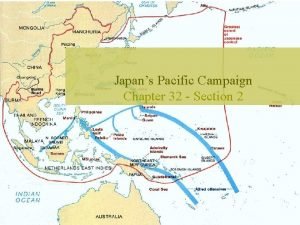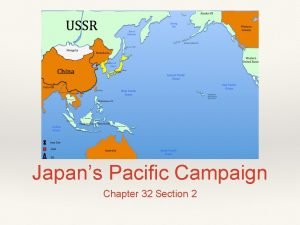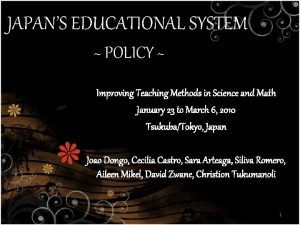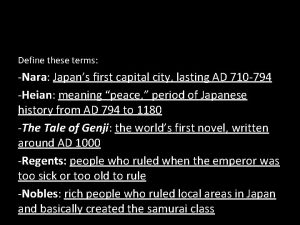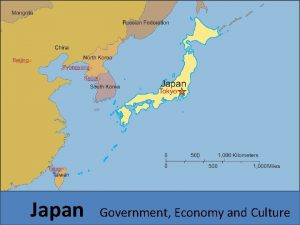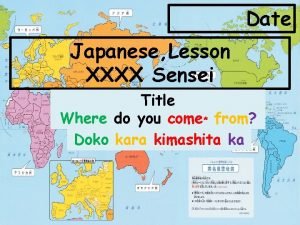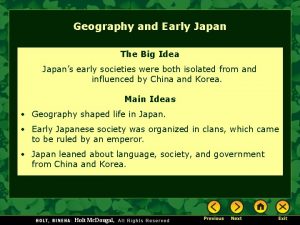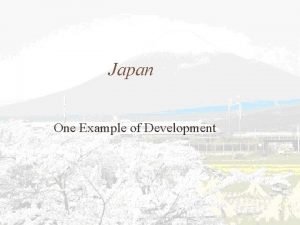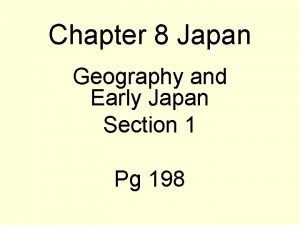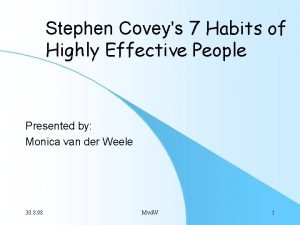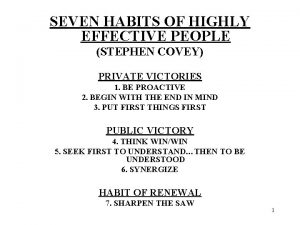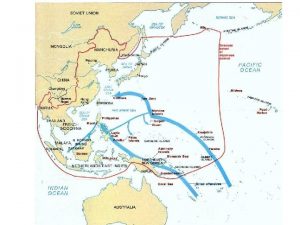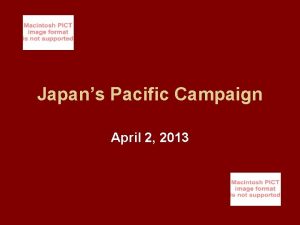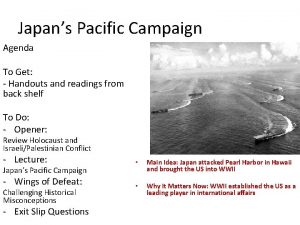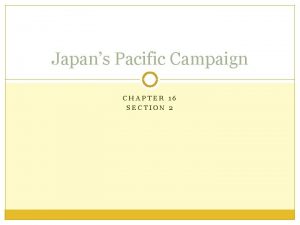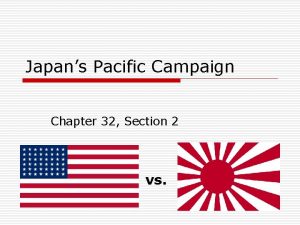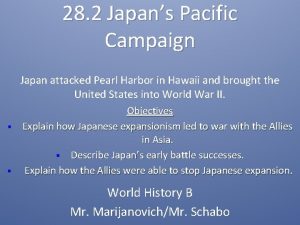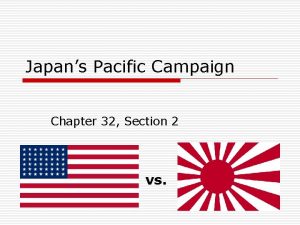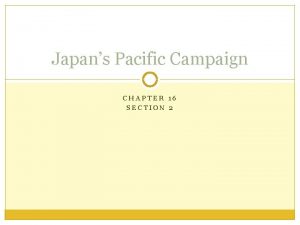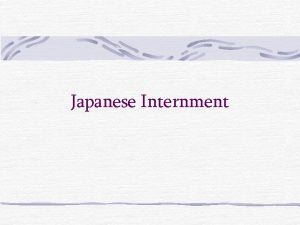Japans Pacific Campaign Japanese Victories Almost at the













- Slides: 13

Japan’s Pacific Campaign

Japanese Victories • Almost at the same time Pearl Harbor was attacked, the Japanese launched bombing raids on Hong Kong (British) and the American-controlled Guam and Wake Island – Also landed an invading force landed in Thailand • Japanese then turned their attention to the Philippines – march into the capital Manila in 1942 – American and Filipino forces take a defensive position on the Bataan Peninsula to try and keep the Japanese from taking the island(s) over – After three months of fighting, Japan took the Bataan Peninsula and the rest of the Philippines shortly after • Japan then looked to the Dutch East Indies - conquered Java, Sumatra, Borneo and Celebes – Islands were rich with resources and minerals and markets • Japan later captured Burma, which bordered India – became a major target for the Japanese • During conquest, Japanese treat prisoners (POWs) cruelly – become infamous for it –POWs were beaten, tortured, beheaded, forced to work – U. S. and British governments censored a lot of information that came from POWs – Western society is shocked that the Japanese – who laid claims to civilization – would act in such monstrous/inhumane way – Ex. Bataan Death March – March of POWs after fall of Philippines army of 80, 000 men are forced to march/ 54, 000 made it

Bataan Death March


The Allies Strike Back • After a string of victories, the Japanese seemed undefeatable, but the Allies (particularly the Americans and Australians) were eager to strike back – U. S. especially wanted revenge for Pearl Harbor • April 1942 - B-25 bombers led by Colonel James H. Doolittle bombed Tokyo and several other cities – Bombs themselves Did relatively little damage but it showed that the Japanese were not invincible – First time the Japanese became insecure: “We started to doubt that we were invincible” • Japan targeted Midway Island – 1500 miles west of Hawaii and a key American airfield – Thanks to Allied codebreakers, Admiral Chester Nimitz, commander in chief of the U. S. Pacific Fleet, – learned that a huge Japanese force was heading to Midway Admiral Yamamoto was commanding the fleet itself – hoped the attacked would draw the whole of the U. S. Pacific fleet from Pearl Harbor – U. S. forces hid beyond the horizon and allowed Japan to attack the Island – let first wave of Japanese planes take off before then American planes swooped in and attacked the carriers – American pilots disabled all the Japanese aircraft carriers (4) destroyed 332 planes – Yamamoto ordered the fleet to withdraw – U. S. victory signaled a change in the Pacific theater of World War II


An Allied Offensive • Allies morale is high after the victory at Midway; the battle put them firmly on the offensive • Problem: – Japanese established themselves in hundreds of Pacific Islands; traditional warfare (clearing enemy points) was going to be difficult – Which island do Allies target in Pacific? • Douglas Mac. Arthur—American army commander in Pacific – developed a plan to the solve the dilemma of Japanese presence in the Pacific – Mac. Arthur believed tat storming each island would be a costly effort with little yield – use money and resources – Plan - “Island-Hop” - Attack weaker Japanese bases while moving closer to Japan; avoid the stronger bases • First target presented itself; U. S, military leaders learned that the Japanese were building a huge air base on the Island of Guadalcanal in the Solomon Islands – Allies needed to strike fast before it was finished (launch base against Allied bases/Hawaii again) • August 7, 1942 – U. S. troops engaged the Japanese in the Battle of Guadalcanal—hellish battle that ends in Allied victory after 6 months of grueling fighting – Hot, humid, and full of mosquitos – was described as being able to rot a body within hours – U. S. troops had little trouble seizing the airfield; it was battle for control of the island that turned the conflict bloody and savage like – Japan lost 24, 000 of its 36, 000 forces on the island; called in the Island of Death – didn’t help that Japan had an honor code that where it was better to die in battle than fail/be captured – Prevented the advancement of Japanese presence in the Pacific; Put Japan on the defensive from the Allies

Douglas Mac. Arthur: “I Shall Return”


Japanese Americans and the War • Japanese Americans face prejudice after Pearl Harbor attack – There were rumors of Japanese spies living in the Japanese-American communities in the states – possibly linked to Pearl Harbor attack – FDR issued order 9066 – Army is allowed to evacuate populations from military areas to be relocated elsewhere – California, Washington, and Oregon declared military areas – Japanese Americans in these states had to register with government offices – Other Asian groups, particularly Chinese, wear images/signs that informed Americans that they were not Japanese so that they wouldn’t be persecuted • FDR issued Order 9066 – Allowed army to put Japanese Americans in interment camps in 1942 – Physical maltreatment was rare; built communities resembling that of everyday life (schools, newspapers, organized sports, etc. ) – Most of the Japanese that were interned were Nisei, or native-born American citizens (second generation Japanese-American) – Many volunteered for military service and fought for the United States even though their families remained in the camps – Several factors – hoped to improve their image in the states, wanted more opportunities outside of the camps, etc.

• • • Period 5 – 1750 A. D. /C. E to 1900 A. D/C. E. Colonies in the Americas (north and south) gained independence from their mother countries – extended from Enlightenment ideology Europe and the United States industrialize during the 1800 s – develop technologies based on steam power, telegraph lines, railroads, canals, steamships, etc. Facilitates communication and transportation between regions and countries Demands of industrialization lead to the onset of Imperialism, where countries subjugate other countries and take control of their government/economy New racial ideologies such as Social Darwinism justify imperialism – “white man’s burden” People develop a new sense of commonality or pride based on shared language, religion, social customs, etc. – Nationalism – unites territories such as Germany and Italy Imperialism leads to competition between countries to see who can have the most colonies, who can have the biggest military/navy, etc.

• • Period 6 – 1900 A. D. /C. E to the Present Scientific innovations continue to increase – developments in medicine (vaccines), weaponry (aircraft, submarines, tanks, machine guns/artillery) The political order of the world was determined largely by a handful of countries in Europe (Imperial powers: Britain, France, Germany, ) Russia, Japan and the United States for many years These powers fought each other power or control over certain regions/lands – resulted in World Wars I and II After World War II, the United States enters into an ideological conflict with the Soviet Union – communism vs. capitalism U. S. tries to contain communism through limited wars in Korea and Vietnam Nations that had been under Imperial powers, such as the East Indies, India, Burma, etc. are gain independence (Decolonization) The Soviet Union experiences economic and social hardship; collapses in 1991 New issues such as air pollution, water pollution, deforestation, desertification, cyberattacks and terrorism as well as the possibility of nuclear engagement become new issues people face with the dawning of the 21 st century

Quizziz Review • Students will take out their packet and review period 5 main topics/ideas (5 minutes) • Students will use their devices to search for “Quizizz” • Students will be taken to a main screen with an option to select “Join Game” • Select “Join Game”: Type in 6 digit code shown on the projector screen • As soon as the class is signed in, I will start the online quiz • Students will use their packet to answer questions for the online quiz (one for period 5 and one for period 6) • Students will retake the quiz until they reach high accuracy
 Chapter 32 section 2 japan's pacific campaign
Chapter 32 section 2 japan's pacific campaign Chapter 32 section 2
Chapter 32 section 2 Japans isolation
Japans isolation Japans educational system
Japans educational system Japans first capital
Japans first capital Japans type of government
Japans type of government Sensei title
Sensei title Japans physical geography
Japans physical geography Japans geography
Japans geography How did prince shotoku unify the japanese people?
How did prince shotoku unify the japanese people? Habit 3 of 7 habits
Habit 3 of 7 habits 7 habits of highly effective peoples public
7 habits of highly effective peoples public Sharpen the saw examples
Sharpen the saw examples Voi kéo gỗ như thế nào
Voi kéo gỗ như thế nào
